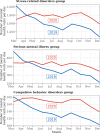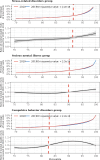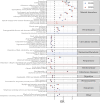Patterns and correlates of mental healthcare utilization during the COVID-19 pandemic among individuals with pre-existing mental disorder
- PMID: 38833458
- PMCID: PMC11149861
- DOI: 10.1371/journal.pone.0303079
Patterns and correlates of mental healthcare utilization during the COVID-19 pandemic among individuals with pre-existing mental disorder
Abstract
How did mental healthcare utilization change during the COVID-19 pandemic period among individuals with pre-existing mental disorder? Understanding utilization patterns of these at-risk individuals and identifying those most likely to exhibit increased utilization could improve patient stratification and efficient delivery of mental health services. This study leveraged large-scale electronic health record (EHR) data to describe mental healthcare utilization patterns among individuals with pre-existing mental disorder before and during the COVID-19 pandemic and identify correlates of high mental healthcare utilization. Using EHR data from a large healthcare system in Massachusetts, we identified three "pre-existing mental disorder" groups (PMD) based on having a documented mental disorder diagnosis within the 6 months prior to the March 2020 lockdown, related to: (1) stress-related disorders (e.g., depression, anxiety) (N = 115,849), (2) serious mental illness (e.g., schizophrenia, bipolar disorders) (N = 11,530), or (3) compulsive behavior disorders (e.g., eating disorder, OCD) (N = 5,893). We also identified a "historical comparison" group (HC) for each PMD (N = 113,604, 11,758, and 5,387, respectively) from the previous year (2019). We assessed the monthly number of mental healthcare visits from March 13 to December 31 for PMDs in 2020 and HCs in 2019. Phenome-wide association analyses (PheWAS) were used to identify clinical correlates of high mental healthcare utilization. We found the overall number of mental healthcare visits per patient during the pandemic period in 2020 was 10-12% higher than in 2019. The majority of increased visits was driven by a subset of high mental healthcare utilizers (top decile). PheWAS results indicated that correlates of high utilization (prior mental disorders, chronic pain, insomnia, viral hepatitis C, etc.) were largely similar before and during the pandemic, though several conditions (e.g., back pain) were associated with high utilization only during the pandemic. Limitations included that we were not able to examine other risk factors previously shown to influence mental health during the pandemic (e.g., social support, discrimination) due to lack of social determinants of health information in EHR data. Mental healthcare utilization among patients with pre-existing mental disorder increased overall during the pandemic, likely due to expanded access to telemedicine. Given that clinical correlates of high mental healthcare utilization in a major hospital system were largely similar before and during the COVID-19 pandemic, resource stratification based on known risk factor profiles may aid hospitals in responding to heightened mental healthcare needs during a pandemic.
Copyright: © 2024 Lee et al. This is an open access article distributed under the terms of the Creative Commons Attribution License, which permits unrestricted use, distribution, and reproduction in any medium, provided the original author and source are credited.
Conflict of interest statement
I have read the journal’s policy and the authors of this manuscript have the following competing interests: JWS is a member of the Scientific Advisory Board of Sensorium Therapeutics (with equity), and has received grant support from Biogen, Inc. He is PI of a collaborative study of the genetics of depression and bipolar disorder sponsored by 23andMe for which 23andMe provides analysis time as in-kind support but no payments.
Figures




Similar articles
-
Patterns of psychiatric healthcare use during pandemic times among boys and girls with pre-existing diagnoses: a Norwegian nationwide primary and specialist healthcare registry study.BMC Psychiatry. 2025 Jan 22;25(1):68. doi: 10.1186/s12888-024-06422-7. BMC Psychiatry. 2025. PMID: 39844080 Free PMC article.
-
Changes in Diagnostic and Demographic Characteristics of Patients Seeking Mental Health Care During the Early COVID-19 Pandemic in a Large, Community-Based Health Care System.J Clin Psychiatry. 2021 Mar 3;82(2):20m13685. doi: 10.4088/JCP.20m13685. J Clin Psychiatry. 2021. PMID: 33979485
-
Disruptions in Care for Medicare Beneficiaries With Severe Mental Illness During the COVID-19 Pandemic.JAMA Netw Open. 2022 Jan 4;5(1):e2145677. doi: 10.1001/jamanetworkopen.2021.45677. JAMA Netw Open. 2022. PMID: 35089352 Free PMC article.
-
[Utilization of mental health services in Germany during the first year of the COVID-19 pandemic-Systematic review and meta-analysis].Nervenarzt. 2025 May;96(3):257-265. doi: 10.1007/s00115-025-01812-y. Epub 2025 Mar 7. Nervenarzt. 2025. PMID: 40053131 Free PMC article. German.
-
Risk of SARS-CoV-2 infection, severe COVID-19 illness and COVID-19 mortality in people with pre-existing mental disorders: an umbrella review.BMC Psychiatry. 2023 Mar 20;23(1):181. doi: 10.1186/s12888-023-04641-y. BMC Psychiatry. 2023. PMID: 36941591 Free PMC article.
Cited by
-
Changes in utilization of in-person and virtual outpatient mental health visits before and during the COVID-19 pandemic: An observational cohort study.Medicine (Baltimore). 2025 Apr 25;104(17):e42305. doi: 10.1097/MD.0000000000042305. Medicine (Baltimore). 2025. PMID: 40295248 Free PMC article.
-
Gaps in psychiatric care before and after the COVID-19 pandemic among patients with depression using electronic health records.Psychiatry Res. 2025 Feb;344:116354. doi: 10.1016/j.psychres.2025.116354. Epub 2025 Jan 6. Psychiatry Res. 2025. PMID: 39799819
References
MeSH terms
LinkOut - more resources
Full Text Sources
Medical

